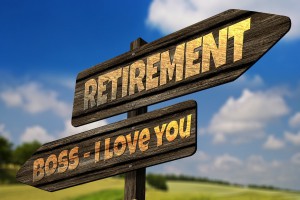When should someone start planning for retirement? Fidelity Investments recommends most young people try to save up 2x their annual salary by the time they turn 35, which is a pretty good benchmark to shoot for. Unfortunately, retirement is so far off the mind of most young people that they find their retirement account is completely empty after turning 30. What can a person do to make sure they are prepared?
Social Security
 Social Security is a very wide-ranging social welfare system in the United States, paid for by payroll taxes (an amount deducted from each person’s paycheck). The biggest part of social security (in terms of the total amount of benefits paid out) is old-age pensions.
Social Security is a very wide-ranging social welfare system in the United States, paid for by payroll taxes (an amount deducted from each person’s paycheck). The biggest part of social security (in terms of the total amount of benefits paid out) is old-age pensions.
All workers in the United States who have paid in to Social Security are eligible to receive a monthly pension payment from the Social Security Administration after they retire. Workers need to work at least 40 years to receive full benefits, and their specific benefit amount is determined by how much they have paid in over the course of their working life. You don’t have to do anything to be eligible to receive an old-age pension from Social Security other than pay your normal payroll taxes. Unless you are self-employed, this should be automatic (if you are self-employed, you need to pay the Self Employed Contributions Act Tax (SECA)).
Social Security payments are skewed towards helping the poorest retirees. The system was first created during the Great Depression, when over 50% of all retired people lived below the federal poverty line. While you will get a bigger pension if you paid more in to the system over your career, Social Security is still designed primarily as a “safety net” – a small supplement to help prevent retired people from having no means to afford a basic living standard. Even today, Social Security payments are credited with lifting 20% of all retired people out of poverty.
How does it fit into my retirement plan?
If you have a well-built retirement plan, you should not be relying on social security payments to make up the bulk of your retirement income. Remember: Social Security is a safety net – there if you need it, but if everything goes well it should not need to be a major component of your retirement income.
Retirement Accounts
In recent years, the most popular way to prepare for retirement has been to save and invest to build up wealth over time, and use that savings to live off in retirement.
Cash Savings

Cash Savings are the savings you keep in a savings or checking account (or even under your mattress). For most of history, this was the primary means that people used to save for retirement – keeping liquid assets that can be used to live off in old age.
One of the biggest problems with cash savings is taxes – you need to pay income tax on the entirety of your income, and more tax on any interest you earn on the savings. Cash savings also do not grow. The amount you have saved up will slowly shrink over time as value is lost to inflation.
Traditional IRA Accounts
 “IRA” stands for “Individual Retirement Arrangement”. These are retirement accounts that the government recognizes, and gives individuals certain incentives to have and build. With a traditional IRA, the government lets you take a certain amount of your income and deposit it directly into a retirement account. This amount is not taxed, so you can deduct your retirement savings from your income to reduce your tax bill in the short term, up to a certain limit (you can’t, for example, add 100% of your income to your retirement account one year and pay no income tax).
“IRA” stands for “Individual Retirement Arrangement”. These are retirement accounts that the government recognizes, and gives individuals certain incentives to have and build. With a traditional IRA, the government lets you take a certain amount of your income and deposit it directly into a retirement account. This amount is not taxed, so you can deduct your retirement savings from your income to reduce your tax bill in the short term, up to a certain limit (you can’t, for example, add 100% of your income to your retirement account one year and pay no income tax).
Once you have your savings in a dedicated IRA account, it can also be invested in stocks, bonds, mutual funds, certificates of deposit, real estate, or other investment instruments. This gives an IRA another major advantage over cash savings – you can help your retirement savings grow through investment. The added value to your IRA (like dividends, interest, and profits from stock trading) is also not taxed while it is in the account. When you retire and begin withdrawing from your IRA, you do need to pay tax on what you take out.
A disadvantage of an IRA is that the money is “locked in”. You cannot take money out of your IRA without taking a huge tax penalty, so it cannot be used to buy a house, for example. If you have a large amount of your IRA invested in stocks, it is also possible to lose a large amount of your savings if your investments fall in value.
Roth IRA Accounts
Roth IRA accounts operate very similarly to Traditional IRAs, the main difference being taxes.
With a Traditional IRA, deposits you make into the account are tax-free, but you pay income tax when withdrawing it when you are retired. With a Roth IRA, you pay the full income tax when you make the contribution, but you do not pay any tax when you withdraw. This means that if you think the tax rates will go up by the time you retire, you will probably take a Roth IRA, but if you think they will go up, you would take a Traditional IRA.
There are also some other advantages, particularly that you can withdraw cash from a Roth IRA account at any time without tax burden (so long as it was cash you put in, not added value)
Employer Retirement Help
Many professional jobs offer some sort of retirement assistance to their employees. This is almost exclusively the case with salaried positions that have an employment contract, or union jobs that have collective bargaining agreements.
Employer Pensions
Employer pensions are a check you receive from your employer every month after you retire. At one time, employer pensions made up the majority of retirement income for the elderly. Employer pensions are generally much lower than a normal paycheck, but their total amount is generally determined by how long you worked for an employer, and how much you were earning.
There are some downsides the employer pensions. The biggest one is that if your employer goes bankrupt, you may lose most or all of your pension payments (generally speaking, employers are required to continue to pay pensions even after going bankrupt, but the amounts may be reduced). Government pensions are not immune to this, as many retirees in Detroit were shocked to find out in 2015 when the city was forced to cut its pension payments.
401(k) Accounts
 401(k) accounts were created almost by accident – they were added as a way for people to defer paying taxes on income until a later date. A tax consultant named Ted Banna realized that this obscure tax code called “401(k)” could be used to make cheap, simple retirement accounts. 401(k) accounts are created through your employer, with the employer making their own contributions (often matching how much you put in). This means that your employer is paying in to your retirement account while you are still working, so you are not reliant on their continued existence in retirement (like a pension).
401(k) accounts were created almost by accident – they were added as a way for people to defer paying taxes on income until a later date. A tax consultant named Ted Banna realized that this obscure tax code called “401(k)” could be used to make cheap, simple retirement accounts. 401(k) accounts are created through your employer, with the employer making their own contributions (often matching how much you put in). This means that your employer is paying in to your retirement account while you are still working, so you are not reliant on their continued existence in retirement (like a pension).
The main advantage of a 401(k) account is that you don’t pay the income tax on your contributions right away, you can put it off until after retirement when you withdraw. This makes it similar to a traditional IRA, but with the 401(k) you don’t need to pay additional taxes on the capital gains and interest (which you do with the traditional IRA). If you prefer it the other way around, there are also Roth 401(k) accounts, which let you pay the tax immediately.
Which Method Do I Use?
Before the 1970’s, most people’s retirement plan was a company pension and social security, plus any other savings they might have accumulated. It was common for retirees to sell their house and move into something smaller, using the profit as their main retirement savings.
The exact retirement plan you choose will vary greatly based on what programs your employer offers, but the main idea to keep in mind is to always be saving!
Pop Quiz
[mlw_quizmaster quiz=80]
